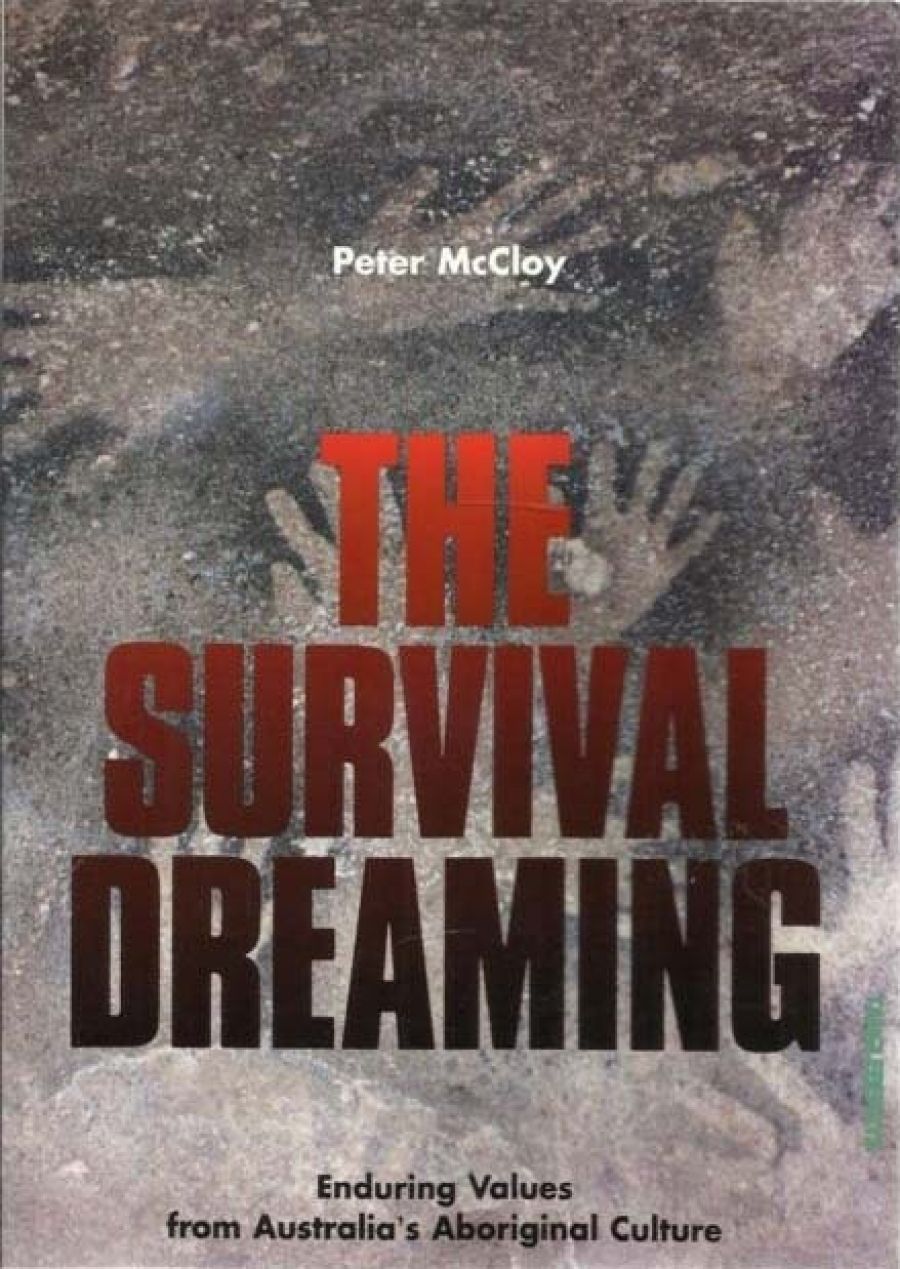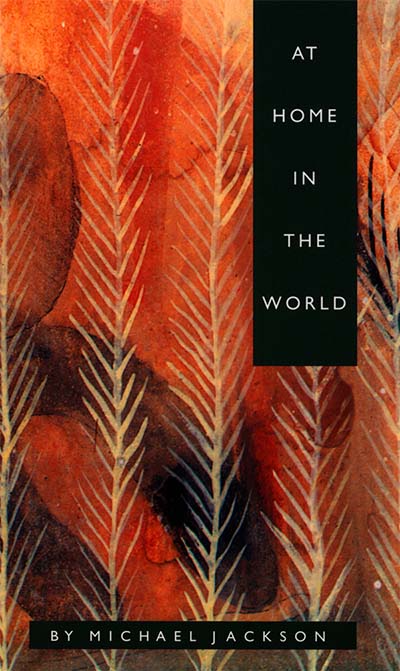
- Free Article: No
- Contents Category: Indigenous Studies
- Review Article: Yes
- Article Title: Why this subject?
- Online Only: No
- Custom Highlight Text:
Terry Southern once wrote a short story about a black jazz musician cultivated by a white jazz fan. After evaluating the fan’s motives the jazz man cuts him loose as someone with an unfocused but suspect desire for the exotic other.
- Book 1 Title: At Home in the World
- Book 1 Biblio: HarperCollins, $16.95pb, 189pp
- Book 2 Title: The Survival Dreaming
- Book 2 Biblio: Management Interface $16.95pb, 147pp
- Book 2 Cover Small (400 x 600):

Similarly, reviewing books written by non-Aboriginals on Aboriginal subject matter, one is always inclined to ask aloud – why the choice of this subject? Which may seem a bit unfair. But that question has its origins in the historical experience of the Aboriginal community and can be asked out of a spirit of curiosity – not interrogative hostility. The why of each of these books can be summarised as a concern with home. Peter McCloy, the author of The Survival Dreaming, sets out to confirm his own sense of home in Australia and Michael Jackson’s At Home in the World meditates on the meaning of home in contemporary society.
Peter McCloy, who is described on the dust jacket of The Survival Dreaming as an author, speaker, and business trainer, writes that he was in Moree when the Freedom Riders came through in the 1960’s. Convinced of the rightness of their cause he joined their picket lines. Aborigines didn’t feature in his life again until the Bicentenary when he became disturbed by Aboriginal protests and later on by Native Title legislation. But during a visit to Central Australia he ‘discovered a people with a soft loving voice’, a people ‘claiming only the right to preserve the values that have served them so well for thousands of years’.
Each chapter of The Survival Dreaming begins with an address to a Warramirri elder David Burramurra (whom it appears McCloy never met) and McCloy’s tendentious use of language becomes evident from the moment he opens his mouth:
Burramurra, my brother, I have lived in this land longer than you. I have mingled my blood and my sweat with this land, and I have treated it as well as I know how, and I too love it. And like you I fear losing my land as my ancestors lost theirs, and I must learn to share it and care for it and say Welcome to My Land.
Though ostensibly a book designed to promote reconciliation it is evident that it is a reconciliation with its terms defined by McCloy:
No wonder we fear Aboriginal rights to ownership of the land when we mean what we mean by the word ‘own’; and how little we have to fear if we understand what the Aborigines mean! The only question to be answered is this: Who is an Aborigine, and will they accept the obligations of owning the land?
In another spirited passage he writes:
There are those, more white than black, who would use your people as a point of leverage in their quest for power and wealth; the politicians, and the myall blacks. With them comes death, for having used you they will discard you, or even worse, live on in the pretence that they are you. And they will enlist many of the uninitiated, if you will not teach them first.
This book is so wrong headed and hostile to most of the Aboriginal community the best response is to refuse provocation. Having said that I was surprised to see the word myall – which I haven’t heard since childhood, being revived by a non Aboriginal and used to abuse Aborigines.
The challenge with a book like The Survival Dreaming is to identify the rhetorical moves and cultural assumptions it shares with more respectable literature and social policy dealing with Aboriginal culture. For instance in McCloy’s elision of racial difference and historical experience in favour of some quality of Aboriginality, accessible to black and white, the Millennium series ‘New Age Aboriginality’ comes to mind. Likewise The Survival Dreaming’s identification of ‘real Aborigines’ is mirrored in the repressive constructions of Aboriginality promoted by the Federal Government.
Michael Jackson’s At Home in the World is more deserving of serious consideration. If Bruce Chatwin’s The Songlines is flaky, if entertaining, in its simple characterisations and not quite believable English adventurer/narrator, Jackson is a self-reflexive traveller, a deliberately self-effacing subject; but one who sees and pitilessly records everything, from the mucus on children’s faces to the intoxicated distress of a woman for whom the desert is a claustrophobic space full of bad memories. This recording angel approach is ultimately what I found disquieting about the book. I had milder concerns about some of its stylistic elements. Like Chatwin, Jackson travels loaded with intellectual baggage. By page four we have had references to Salman Rushdie, Susan Sontag, W.B. Yeats, John Berger, Blaise Cendars, Simone Weil, Edward Said, Freud, Thomas Wolfe, and Novalis. This works effectively in places but sometimes seems gratuitous. And along with the philosophy we get descriptive writing like this:
We were dead beat after driving all day through the desert, a11d the light was fading as we approached Yuendumu. We turned down a side road. found a cleari11g. and made camp. After a meal of eggs and hash browns we crawled into our swags by the fire. The mulga looked spectral in the last light. The wind fanned our faces. An insect trilled feebly in the grass. I drifted asleep still feeling the Toyota lurching and jolting over the hard dirt road.
This is part of Jackson’s low-key presentation but for a while there I thought I was back on Hemingway’s ‘Big Two-Hearted River’. While Jackson identifies displacement and homelessness as a condition of modernity his consideration of the meaning of home is sometimes weakened by writing which tends toward the banal:
As I spaded the spinifex from the hard, brick-red earth to make a camp, or lit a fire of mulga in the gathering dusk, I felt renewed. If home is where a person is at peace with himself, where he can honestly say there is nowhere else he would rather be, then the desert had become my home.
And later:
I think I knew what it means to be at home in the world. It is to experience a complete consonance between one’s own body and the body of the earth.
Notwithstanding this At Home in The World has much to recommend. The author rejects the proprietorial style of many non-Aboriginals who’ve written about traditional communities, and at numerous points in the relaxed and meandering narrative there are luminous insights and moments of quiet passion. These range from the social to philosophical. And a simple observation, such as the hesitancy some of the Walpiri feel when dealing with Whites in situations where the Whites are in control, illustrates Jackson’s conclusion that the meaning of home isn’t found in the ‘substantive’ – land, house, or family. But while home can never be a place that is given, land rights and the recognition of native title can provide a space for the re-creation of home.


Comments powered by CComment